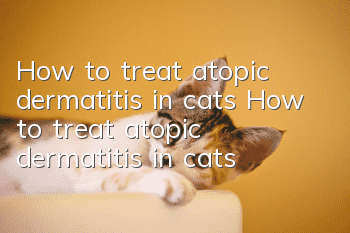How to treat atopic dermatitis in cats How to treat atopic dermatitis in cats

How to treat atopic dermatitis in cats? Cat owners should be afraid that their cat owners will get sick. After all, sick cat owners make people feel distressed. How to treat atopic dermatitis in cats?
Atopic dermatitis is referred to as CAD. The main symptom of CAD is itching, which is manifested by excessive scratching, rubbing, biting, and self-licking. Skin erythema can be seen in early symptoms, but most lesions are caused by chronic inflammation and self-scratching, so epidermis (scratches), pigmentation (skin darkening), lichenification (skin thickening, roughness) and damage will occur. Symptoms of hair loss. Atopic dermatitis in cats can be difficult to treat, and sometimes you just need a little luck.
The incidence of atopic dermatitis varies and has been reported in some studies to be as high as 73% of all allergic cats, or second only to flea allergy. There may be a hereditary predisposition here, as some families have a higher incidence. rate, but no specific gene has been found. There are seasonal and non-seasonal allergies in cats. A study of 66 cats with atopic dermatitis found that: 50% had fleas, 58% were non-seasonal, 39% had both seasonal and non-seasonal allergies, and 5% were only allergic to pollen. , dust mites in the home are the most common non-seasonal reaction.
Distribution:
Variable, localized areas can be on the head, face, ears, neck, inside of the forelimbs, ventral and lateral sides of the body, back of the thighs, or all over the body.
Clinical symptoms: pruritic papules and crusts (miliary dermatitis), hairlessness caused by self-inflicted hair-barber type hairlessness (symmetrical hair loss in cats), erosive-exfoliative dermatitis caused by self-inflicted damage, eosinophilic dermatitis Granulomatous complex lesions, asthma, combined symptoms. Indistinguishable from other allergies, although there may be seasonality, many cases are accompanied by flea allergy, and some have food allergies. In cats, respiratory symptoms are more common.
Diagnosis:
Intradermal antigen testing is more difficult to do and interpret than in dogs, and in vitro testing is helpful.
Treatment methods:
1. Glucocorticoids
Glucocorticoids are the most commonly used drugs to control AD pruritus. Cautious dosing and short-term administration can also cause minor side effects in animals. Many dermatologists often choose this drug when other treatments have failed. The specific recommended medications are: prednisone, prednisolone and methylprednisolone, 0.5-1mg/kg/day, orally, for 5-7 days. Since glucocorticoids are the AD treatment drugs with the strongest side effects, they are not suitable for long-term use unless there are no otheralternative method. The antipruritic mechanism of this type of drug is to inhibit phospholipase A2, which is the rate-limiting step in the synthesis of prostaglandins and leukotrienes, effectively blocking the entire inflammatory cascade and quickly relieving itching. The side effects are equally famous.
Common symptoms of short-term use include shortness of breath, polyuria, polydipsia and polyphagia. Side effects vary greatly between individuals, making it difficult for veterinarians to predict. In some cases, iatrogenic Cushing's syndrome occurs simply because of the use of steroid-containing eye drops, while in other cases, multiple injections of long-acting steroids have no clinical side effects. In contrast, oral and injectable short-acting corticosteroids are the conventional options, and longer-acting injectables are safer.
2. Antihistamines
Antihistamines are best used early in the itching season and are not effective in severe itching. The simultaneous use of antihistamines, essential fatty acids, and topical treatments can significantly control the itching in some cases, thereby reducing the incidence of superficial pyoderma and other secondary complications. First-generation H1 blockers are representatives of antihistamines. Due to their anticholinergic properties, they are prone to side effects of drowsiness or excitement. The drug's antipruritic effect is unpredictable, but the risks are low, making it suitable for use in most cases. It usually takes 14-21 days to take effect. These drugs moderately modulate the synthesis of leukotrienes and prostaglandins (fatty acids and arachidonic acid are the precursors of both) through competitive inhibition. The metabolites of essential fatty acids contain few inflammatory substances. When given in high doses, omega-3 fatty acids can replace arachidonic acid in the same enzyme, hence its anti-inflammatory mechanism. So taking essential fatty acids together can reduce the dosage of steroids and antihistamines used to treat allergies. Some people have investigated that daily oral administration of fish oil containing eicosapentaenoic acid (EPA, 66 mg/kg) also has the above effect.
- Will the cat recognize its owner again?
- Can cats eat fried peanuts?
- Is it normal for a two-month-old kitten to shed tears?
- Are elderly cats susceptible to joint disease? Symptoms of joint disease in pet cats
- The importance of vitamin C to cats. Do exotic shorthair cats need to supplement vitamin C?
- Why do cats always like to lick their own fur?
- What do Balinese cats eat? What are the eating habits of Balinese cats?
- Knowledge in pet cat litter box
- What does cat diarrhea look like?
- Why do kittens love to lick people?



